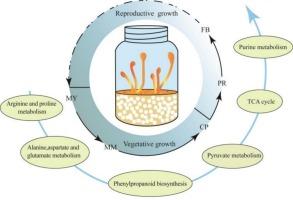代谢组学分析揭示了蛹虫草液体培养子实体的形成机制
IF 9.8
1区 农林科学
Q1 CHEMISTRY, APPLIED
引用次数: 0
摘要
蛹虫草是一种功能性真菌,以其显著的营养和治疗价值而闻名。然而,在液体培养中控制其生长和子实体形成的机制仍然知之甚少。在这项研究中,我们采用了UHPLC-MS/MS-based非靶向代谢组学方法来分析军棘草在关键发育阶段的代谢组学。共鉴定出228种代谢物。其中,氨基酸及其衍生物所占比例最高,共鉴定出894种。有机酸是第二丰富的化合物,共有244种。不同生长阶段的代谢物谱差异显著。氨基酸、有机酸和脂质可以作为区分发育阶段的潜在标志。值得注意的是,在菌丝增殖、原基分化和子实体成熟过程中,6个关键代谢途径发生了显著变化。我们的研究结果阐明了军状芽孢杆菌在液体培养中生长的代谢驱动因素,为菌株改良和生物活性代谢物的工业规模生产提供了机制基础。本文章由计算机程序翻译,如有差异,请以英文原文为准。

Metabolomics analysis reveals the formation mechanism of Cordyceps militaris fruiting bodies in liquid culture
Cordyceps militaris is a functional fungus renowned for its significant nutritional and therapeutic value. However, the mechanisms governing its growth and fruiting body formation in liquid culture remain poorly understood. In this study, we employed UHPLC-MS/MS-based untargeted metabolomics to profile the metabolome of C. militaris across key developmental stages. A total of 2288 metabolites were identified in C. militaris. Among these, amino acids and derivatives accounted for the highest proportion, with 894 types identified. Organic acids are the second most abundant compounds, with 244 types identified. Metabolite profiles varied significantly across growth stages. Amino acids, organic acids, and lipids may serve as potential markers for distinguishing developmental stages. Notably, significant alterations were observed in six key metabolic pathways during mycelial proliferation, primordium differentiation, and fruiting body maturation. Our findings elucidate the metabolic drivers of C. militaris growth in liquid culture, providing a mechanistic basis for strain improvement and the industrial-scale production of bioactive metabolites.
求助全文
通过发布文献求助,成功后即可免费获取论文全文。
去求助
来源期刊

Food Chemistry
工程技术-食品科技
CiteScore
16.30
自引率
10.20%
发文量
3130
审稿时长
122 days
期刊介绍:
Food Chemistry publishes original research papers dealing with the advancement of the chemistry and biochemistry of foods or the analytical methods/ approach used. All papers should focus on the novelty of the research carried out.
 求助内容:
求助内容: 应助结果提醒方式:
应助结果提醒方式:


